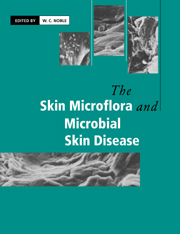Book contents
- Frontmatter
- Contents
- List of contributors
- Preface
- 1 The basis of the skin surface ecosystem
- 2 Nutrition of cutaneous resident microorganisms
- 3 Physical factors affecting the skin flora and skin disease
- 4 Coryneform bacteria
- 5 Coryneforms as pathogens
- 6 Staphylococci on the skin
- 7 Staphylococci as pathogens
- 8 Streptococci and the skin
- 9 Other cutaneous bacteria
- 10 Fungi and fungal infections of the skin
- 11 Bacterial and fungal skin disease in animals
- 12 Viral skin disease in man
- 13 Viral skin disease in animals
- 14 Microbial interactions on skin
- 15 Adherence of skin microorganisms and the development of skin flora from birth
- 16 Skin disinfection
- Index
15 - Adherence of skin microorganisms and the development of skin flora from birth
Published online by Cambridge University Press: 04 December 2009
- Frontmatter
- Contents
- List of contributors
- Preface
- 1 The basis of the skin surface ecosystem
- 2 Nutrition of cutaneous resident microorganisms
- 3 Physical factors affecting the skin flora and skin disease
- 4 Coryneform bacteria
- 5 Coryneforms as pathogens
- 6 Staphylococci on the skin
- 7 Staphylococci as pathogens
- 8 Streptococci and the skin
- 9 Other cutaneous bacteria
- 10 Fungi and fungal infections of the skin
- 11 Bacterial and fungal skin disease in animals
- 12 Viral skin disease in man
- 13 Viral skin disease in animals
- 14 Microbial interactions on skin
- 15 Adherence of skin microorganisms and the development of skin flora from birth
- 16 Skin disinfection
- Index
Summary
Among the various known ecological factors that determine host–parasite relationships is the specific binding of microorganisms to cells and tissues. This important process is called adherence; the microbe-borne molecule that connects with a host receptor is an ‘adhesin’. Like those tenacious microorganisms inhabiting streams and other marine environments, the flora indigenous to skin and mucosa has the selective advantage of being able to stick to substrates, resisting the abrasive forces of air and fluid currents that would otherwise wash it away. Furthermore, like the attachment of viruses to their target cells, microbial adherence is a significant, if not crucial, step in infectivity and in subsequent infectious disease. Indeed, the molecular principles previously established for specific viral attachment have been found appropriate for bacteria and fungi as well.
The macroscopic perspective
Although recognized as early as 1908 when G. Guyot observed attachment of bacteria to erythrocytes, medical interest in adherence stems from the research of Gibbons and colleagues on the microbial ecology of the oral cavity. Their analyses of the general phenomenon of adherence were soon verified with intestinal, vaginal, and nasal mucosal cells. Reflecting the relative proportions of flora observed in the mouth, Streptococcus salivarius adhered poorly to teeth, moderately to buccal cells, but in high numbers to epithelial cells of the tongue, while Strep. mitis attached well to teeth and cheek but only moderately so to tongue. In contrast, Enterococcus faecalis and Escherichia coli, named for their normal intestinal habitat, were infrequently detected on oral surfaces and had a correspondingly low adherence.
- Type
- Chapter
- Information
- The Skin Microflora and Microbial Skin Disease , pp. 355 - 372Publisher: Cambridge University PressPrint publication year: 1993
- 5
- Cited by



